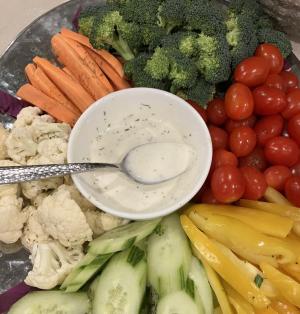At a recent gathering of friends, we served Prosecco, a charcuterie plate of cured meats and cheeses, a selection of miniature cheesecakes, and the least favorite of all the choices, a crudités platter. Here I was trying to be healthy, but I must have missed the mark. As you can see in the photo, the dish featured a selection colorful vegetables cut into bite-size pieces to encourage dipping into the requisite accompaniment of ranch dressing.
In a 2018 New York Times article, Ligaya Mishan tells us the term crudité comes from the French and simply means “rawness.” We can thank James Beard for an early recipe in his 1965 cookbook with instructions for arranging a display of “green onions, radishes, celery, tiny artichokes, asparagus, turnips, carrots - all raw.” According to Mishan, if you see raw vegetables on a modern menu, they’re likely unfamiliar specimens arrayed like a modernist sculpture.
As for our crudités platter (note the use of the plural) all the leftovers were packed at the end of the event, wrapped and refrigerated for future use. As we inventoried our options, some answers were easier than others. For example, the cucumbers would be best in tzatziki sauce - mixed with yogurt, lemon, olive oil, and herbs. Because the cucumber is chopped and drained of its liquid to make the sauce, these slices would work well.
The carrots, broccoli and cauliflower florets could be blanched - dropped into boiling water for a few moments, then shocked in a cold water bath to stop them from cooking. They’d be stored in a zip top bag in the freezer until you’re ready to use them in a recipe. Alternatively, drizzle them with olive oil and roast them to serve as a side dish. Or, you can add the broccoli florets to a crustless quiche, which you can season with chopped bacon, as in the recipe below.
If you have enough fresh carrots, consider shredding them in a food processor to form the basis of carrot bran muffins; you’ll find all sorts of variations on recipes for this treat on the internet. The yellow bell pepper could be frozen if you have another recipe that doesn’t need it to remain crisp, for example in a future batch of jambalaya or red beans. While it is still fresh, it would be a nice addition to a stir fry to add both color and texture.
The tomatoes will give you all sorts of options - freeze, sauté, roast, or stir them into soup. I keep whole tomatoes in a zip top bag in the freezer to make the tomato soup in the recipe below. You can roast them the same way as the cauliflower, just keep in mind that they will brown and burst open on your baking pan. Once they’re cooked, toss them with pasta for a light sauce or stir them into your tomato “gravy” for another flavor layer.
Although the veggies weren’t a big hit, my leftovers have been standouts on the menu.
Roasted Cauliflower*
1 head cauliflower
2 T olive oil
1 t kosher salt
1 T snipped chives
Preheat oven to 400 F. Line a baking sheet with aluminum foil; set aside. Remove and discard the leaves and core of the cauliflower. Trim into uniform size florets. Spread the cauliflower on the baking sheet and drizzle with olive oil. Toss with a spatula to coat all the pieces. Sprinkle with salt and bake for 15 minutes. Toss the florets again and return to the oven for another 15 minutes. Serve garnished with snipped chives or use in quiche, omelet or risotto. *This technique also works for carrots or broccoli, but watch for too much browning during the second 15 minutes in the oven.
Broccoli Quiche*
4 eggs
1 C half & half
1/4 t oregano
1/2 t salt
1/2 t white pepper
1 C shredded sharp cheddar
6 slices cooked bacon
2 C blanched broccoli florets
Preheat oven to 375 F. Generously coat the inside of a pie pan with nonstick cooking spray; set aside. In a large bowl, whisk together eggs and half & half until smooth. Stir in seasonings; set aside. Scatter the cheese and broccoli across the bottom of the prepared pan. Crumble the bacon into the pan. Gently pour the egg mixture into the pan and bake until lightly browned and set, about 40 to 45 minutes. *Alternatively, line the pan with a prepared pie shell and blind bake it for 15 minutes before adding filling.
Tomato Soup
1 T olive oil
1 chopped onion
2 pressed garlic cloves
1 lb frozen tomatoes
2 C vegetable stock
1/2 t basil
1 t parsley
1/2 t marjoram
salt & pepper, to taste
Heat oil over medium in a soup pot. Add onion and sauté until translucent. Stir in garlic and cook for a minute. Add tomatoes and stock; cook, using a wooden spoon to break tomatoes as they defrost. Once all the tomatoes have broken open, stir in herbs and reduce heat to low; cover and simmer for 20 minutes. Once tomatoes have cooked completely, use an immersion blender to purée the mixture until smooth. If any tomato skins are noticeable, remove them with a slotted spoon. Adjust seasoning to taste with salt and pepper. Yield: 4 servings.
Tzatziki Sauce
8 oz Greek yogurt
1 C sliced cucumbers
1/2 t salt
1 pressed garlic clove
1 T olive oil
1 1/2 t fresh dill
1 T lemon juice
salt & pepper, to taste
Line a colander with cheesecloth and add the yogurt; allow to drain for at least two hours. Place the cucumbers in the center of a clean dishtowel; sprinkle with salt and allow to sit for at least an hour. Draw together the four corners of the towel and squeeze to remove a much liquid as possible. Add cucumbers to the bowl of a food processor along with drained yogurt and remaining ingredients (except salt and pepper). Process until smooth; season to taste with salt and pepper. Serve with gyros as a garnish, cut up vegetables as a dip, or grilled fish as a sauce.




















































